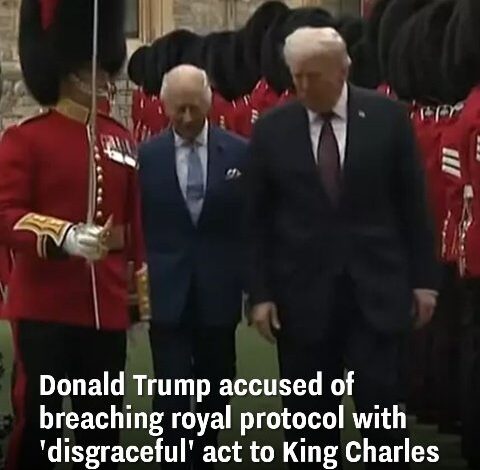Donald Trump faces allegations of violating royal protocol with a disgraceful gesture

Former U.S. President Donald Trump’s state visit to the United Kingdom sparked controversy almost immediately upon arrival in Windsor. Accompanied by First Lady Melania Trump, he was greeted warmly by the Prince and Princess of Wales and formally introduced to King Charles III. Initially, the meeting appeared to proceed smoothly, with the King smiling as he shook Trump’s hand. However, tensions emerged during the guard of honor when Trump briefly broke royal protocol by walking ahead of the monarch, pausing to chat casually with a guard while the King followed behind. Though the incident lasted only moments, it quickly drew widespread attention and criticism.
Video clips of the moment circulated on social media, fueling debate over the former president’s actions. Critics described the move as arrogant and disrespectful, with some comparing it to Trump’s 2018 visit, when he momentarily walked ahead of the late Queen Elizabeth II during a ceremonial troop inspection. Observers argue that such actions indicate a pattern of disregard for established traditions rather than an isolated slip.
Supporters of Trump dismissed the breach, framing it as consistent with his style of defying conventions. They contend that his approach signals confidence and a willingness to challenge outdated rituals. In the UK, however, the optics were more significant. Etiquette experts emphasized that royal protocol is not a matter of personal preference but a symbol of the monarchy’s enduring role as head of state. Walking ahead of the sovereign is seen as a breach of this symbolic order.
Despite the criticism, Trump’s itinerary remained packed. The day included a visit to Queen Elizabeth II’s tomb, a private lunch with the royal family, attendance at the Beating Retreat ceremony featuring military bands and fighter jets, and a state banquet. Security measures were notably stringent, given recent assassination attempts against Trump and the high-profile killing of conservative activist Charlie Kirk, a close ally. British and American agencies are coordinating closely to ensure the visit proceeds safely, but the recent incidents have added tension to an already high-profile trip.
Trump’s relationship with the British monarchy has historically been complex. While he has expressed admiration for the royal family—calling Kate Middleton “so radiant and so beautiful” during this visit—his public appearances often generate scrutiny over etiquette. During his presidency, a similar incident with Queen Elizabeth II drew global headlines, with defenders citing it as an innocent misstep while critics viewed it as emblematic of a broader disregard for protocol. This history intensified reactions to the Windsor breach with King Charles.
Royal protocol carries deep symbolic weight. Observers note that following established order highlights the stability and continuity of the monarchy. Deviations can be interpreted as dismissive of these traditions rather than personal disrespect toward the monarch. As one historian explained, the rules exist “to protect the institution, not the individual. Walking ahead disrupts a symbolic order that has existed for generations.”
Politically, the incident holds significance. Trump is the first modern U.S. president to receive two state visit invitations from the UK, a gesture intended to reinforce the special relationship amid global uncertainties. While supporters view the visit as a display of diplomacy, critics argue that the protocol breach shifts attention from bilateral relations to Trump’s personality. Washington observers may seize the moment as evidence of arrogance, while UK defenders may dismiss it as overblown.
The remainder of the visit still offers opportunities for Trump to demonstrate statesmanship. Successful engagements at the state banquet or a respectful visit to the late Queen’s tomb could redirect focus. Nevertheless, the Windsor incident has already shaped public perception, becoming a defining image of the trip: Trump walking ahead of King Charles, relaxed, while observers debated the implications.
Interpretation of the event varies. Some see it as Trump asserting leadership and confidence, even when tradition dictates restraint. Others view it as another example of his tendency to overshadow established authority. In Britain, where symbolic gestures hold significant meaning, the moment resonated strongly. In the United States, it may reinforce perceptions of Trump as a figure who refuses to yield to protocol.
As the state visit continues, every handshake, step, and interaction will be closely scrutinized. Supporters praise his boldness; critics highlight perceived disrespect. Ultimately, the visit underscores a familiar dynamic: Trump thrives in the spotlight, with controversy following wherever he goes. For better or worse, the former president has once again commanded global attention.